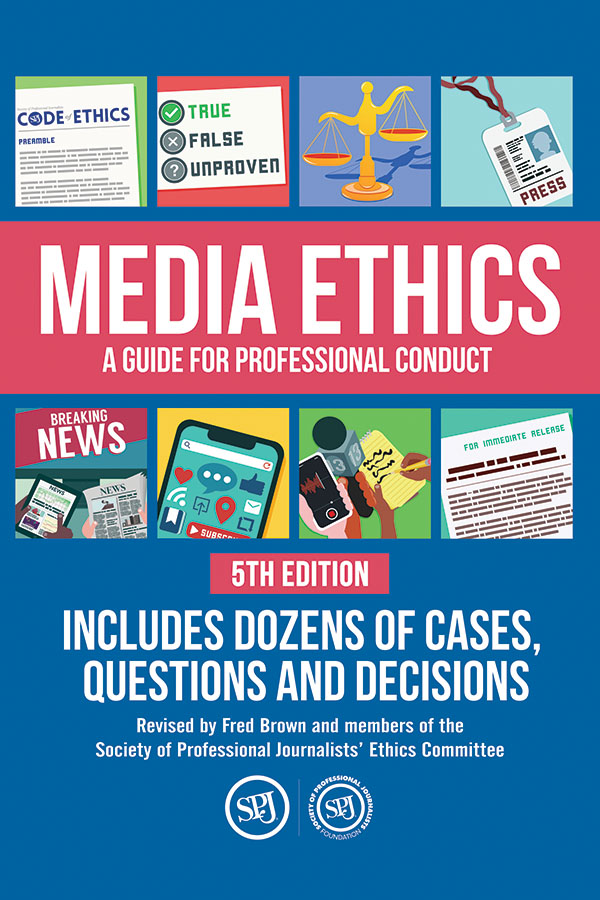Strengthening the Pillars of Free Press: Support the Society of Professional Journalists Foundation.
The free press is more than just an institution; it represents the foundation of our nation and the freedoms we cherish. Your support is not just appreciated—it's essential. With your help, we can ensure that the light of responsible journalism continues to shine brightly, illuminating the path forward for our democracy. Help us reach our year-end goal of raising $50,000.
Donate Today
Ethics Case Studies
The Sting
Now available: Media Ethics: 5th Edition
 Closely organized around SPJ's Code of Ethics, this updated edition uses real-life case studies to demonstrate how students and professionals in journalism and other communication disciplines identify and reason through ethical dilemmas.
Closely organized around SPJ's Code of Ethics, this updated edition uses real-life case studies to demonstrate how students and professionals in journalism and other communication disciplines identify and reason through ethical dilemmas.
Order now:
– Bookshop.org
– Amazon/Kindle
– IndieBound
– More
Ethics Case Studies
– Index
– Kobe Bryant’s Past: A Tweet Too Soon?
– A controversial apology
– Using the ‘Holocaust’ Metaphor
– Aaargh! Pirates! (and the Press)
– Reigning on the Parade
– Controversy over a Concert
– Deep Throat, and His Motive
– When Sources Won’t Talk
– A Suspect “Confession”
– Who’s the “Predator”?
– The Media’s Foul Ball
– Publishing Drunk Drivers’ Photos
– Naming Victims of Sex Crimes
– A Self-Serving Leak
– The Times and Jayson Blair
– Cooperating with the Government
– Offensive Images
– The Sting
– A Media-Savvy Killer
– A Congressman’s Past
– Crafting a Policy
WHAT: Perverted-Justice.com is a Web site that can be very convenient for a reporter looking for a good story. But the tactic raises some ethical questions. The Web site scans Internet chat rooms looking for men who can be lured into sexually explicit conversations with invented underage correspondents. Perverted-Justice posts the men’s pictures on its Web site.
Recently the tactic has spread to the mainstream media. Perhaps the most visible use of the resource has been on the NBC network’s Dateline news show. Many local television stations have used it as well. A Kansas City station, KCTV-Channel 5, may have been the first to show faces and name names. Its six-night report aired during February sweeps, in 2004, taking advantage of information and volunteers provided by Perverted-Justice.com. It helped the station get good ratings.
In December 2003, investigative reporter Steve Chamraz and volunteers from the Web site rented a house in Independence to wait for men who had responded to messages from volunteers who had pretended to be underage boys and girls. Several local men engaged in chat-room conversations with the supposed youngsters.
Eventually, 16 of them showed up at the rented house. Each time, Chamraz and a Channel 5 camera crew were waiting to record the encounter. But one man targeted by the reporting filed a federal lawsuit against Channel 5’s parent company, Meredith Broadcasting; the Web site; and the CBS network. The plaintiff claimed he was misrepresented as a pedophile and it cost him a $50,000-a-year job.
He claimed he never propositioned the “young girl” he chatted with.
The lawsuit challenged only one of several apparent instances of what Chamraz and Channel 5 characterized as “Internet predators” who wanted to “have sex with underage teens.”
But there are broader questions involved here. Here are the questions you might want to ask: Is it ethically defensible to employ such a sting tactic? Should you buy into the agenda of an advocacy group — even if it’s an agenda as worthy as this one?
WHO: Put yourself in the position of a news director or station manager who must decide whether to use the services of Perverted-Justice.com.
Who else has a stake in your decision of whether to make this a major story? Certainly, the community you serve needs to know who might be trolling for children to exploit. It’s important to drive these pedophiles out of the shadows and get them off the street. Your audience will thank you, especially parents with young children.
Certainly, Perverted-Justice.com is a stakeholder. Your reporting will add to its credibility. Is it a reputable group or a bunch of suspect vigilantes, possibly even voyeuristic? Those with the most at stake are the potential perverts caught in the sting. They most certainly will lose their reputations, their jobs and quite likely their freedom, as many of them will be arrested and incarcerated.
There are many questions here. Your task is to put yourself in the position of a news director — or managing editor — who has an opportunity to use information provided by a third party, outside the newsroom, with a clearly defined agenda.
WHY: Identify the competing moral principles. Telling the truth is always the primary responsibility of a journalist. But is this a manufactured “truth”? When you consider minimizing harm, does the harm you do to the Internet predators carry more weight than the harm they might do to the community’s children? Is Perverted-Justice.com itself ethical? Or is it, as one law enforcement officer in Wichita said, “a lawsuit waiting to happen”? Are you damaging your own ethics by using it? What’s the greatest good for the greatest number of people involved?
HOW: Decide how to answer the questions raised in the first part of this exercise. Write down your answer to see if it makes sense. And put your rationale into words. If you were to proceed with a story using these techniques, do you think your viewers and/or readers should be told something about your rationale? Consider making your decision-making process part of your coverage.